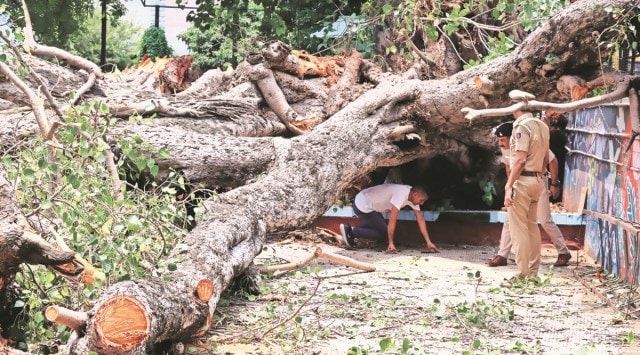Special to Express: Death at Carmel Convent: Accountability is human, not divine
The question of responsibility of loss of life caused by the tragic fall of heritage trees needs answers. Does the responsibility change when such trees grow in government schools, Sukhna Lake, PGIMER or in private schools?
 Officials inspecting the site where the tree fell. (Express Photo by Kamleshwar Singh)
Officials inspecting the site where the tree fell. (Express Photo by Kamleshwar Singh)Chandigarh Trees Preservation Order, 1952, mandates that except with the permission of chief administrator, no tree shall be cut down, lopped or destroyed. The ‘protected trees’ are numbered, and listed in a register and the notice by the chief administrator warns of action against offenders violating the order. Zoning plan of every sector in Chandigarh marks protected trees under the order. Trees that are 100 years old are given heritage status by the administration. Replanting directives contain protective measures and maintenance of fencing, which may be necessary for protection of trees. Accordingly, the administration proudly proclaims 31 heritage trees within Chandigarh.
The question of responsibility of loss of life caused by the tragic fall of heritage trees needs answers. Does the responsibility change when such trees grow in government schools, Sukhna Lake, PGIMER or in private schools? Can the Chandigarh administration shift the blame for maintenance, safety, liability and compensation, if located in private buildings? The 250-year-old trees are babies of the UT administration. Private building owners cannot own or possess heritage/protected trees. With the ownership, liability also travels. The administrators cannot shift gears to disown obligations of neglect on loss of precious human lives.
Torts as civil wrongs for actionable claims are not codified under the Indian law. The Supreme Court in 1996 held that ‘precautionary principle’ and ‘polluter pays principle’ are essential features of sustainable development. In two cases of Nilabati Behera vs State of Orissa and Mehmood Nayyar vs State Of Chattisgarh, the Supreme Court held that superior courts being protectors of civil liberties of citizens, have power, jurisdiction besides an obligation to grant relief in exercise of their extra-ordinary jurisdiction under the Indian Constitution. Award of compensation in writ jurisdiction for contravention of human rights and fundamental freedoms dealing with life and personal liberty is innovated by the Supreme Court to repair damage and provide monetary aid, notwithstanding the rights of the citizen to enforce conventional civil or criminal proceedings for relief.
Justice Rajiv Raina of Punjab and Haryana High Court awarded Rs 60 lakh for a four-year-old boy who suffered triple amputation of his limbs from an electrocution from wires passing over his home in Haryana. Relying upon the dictum for moulding relief in writ jurisdiction for compensation for damages for making “monetary amends” under public law for wrong done for breach of public duty, High Court upholding the principle of ‘strict liability’and consequential negligence in awarding compensation, awarded ‘exemplary damages’ to this child upon whom fate had inflicted a cruel malady. The court concluded that failure to provide statutory safeguards and protective devices against high voltage electricity of dangerous dimensions and not removing live overhead lines passing over roofs of houses, attract the principles of strict liability to “invade the battle ground in fighting for the protection of life and liberty of our people under Article 21 of the Constitution”. The High Court in its verdict issued salutary directions in quantification of monetary compensation, damages and other ancillary matters to secure the ends of justice.
Equally, rule of “strict liability,” must find application for loss of life due to falling of heritage trees. These are not natural calamities, act of God or sovereign functions. Accountability is human, not divine. Man and not God, is answerable. Culpability for disregard and negligence must be fixed on Department of Forest and Wildlife, Chandigarh Administration, who proudly display their title to such heritage trees. Owners of private buildings cannot even touch these trees. Detection of termites, damages by heavy rain, providing protective structures are measures necessitated out of self-responsibility of the Chandigarh Administration, not to be triggered by complaints of bystanders. Dying trees cannot shout for help. Registered, numbered heritage trees in private or public land cannot be treated differently. Heritage trees are so, and will remain so. Destruction, loss of life and tragedies, cannot be shifted by location of such trees to register FIRs against unknown persons. It is time liability is owned and not disowned by the UT administration. Perpetrators must pay. Heads must roll. Examples must be set to define public boundaries. Repudiation by public disclaimers of blame games must be set right. Suo moto notice is attracted for the ball to roll in right directions to pinpoint answerability. Wrongdoers must be brought to the book. History must not repeat itself.
(www.anilmalhotra.co.in
The author was amicus curiae in the High Court matter)


- 01
- 02
- 03
- 04
- 05





























